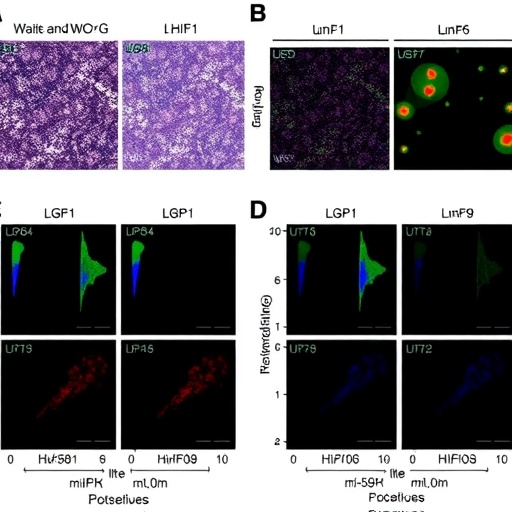In a groundbreaking study published in Reproductive Sciences, researchers Wang et al. delve into the profound impact of a specific microRNA, miR-519d-3p, secreted by the blastocyst on human endometrial stromal cells. This research opens new avenues for understanding the molecular players involved in endometrial physiology, with potential implications for reproductive health and fertility treatments. By elucidating the mechanisms through which miR-519d-3p operates, the authors contribute significantly to our knowledge of the intricate interplay between embryo development and maternal cellular responses.
MicroRNAs (miRs) are small, non-coding RNA molecules that play a crucial role in the regulation of gene expression. They are known to influence a variety of biological processes, including cell proliferation, differentiation, and apoptosis. In the context of early embryonic development, the regulation of these processes is essential for successful implantation and pregnancy. The study by Wang et al. highlights the significance of miR-519d-3p as a modulatory agent in the endometrial microenvironment, demonstrating its ability to alter cellular behaviors in the human endometrium.
The researchers employed human endometrial stromal cells to assess the specific effects of miR-519d-3p. Their findings reveal that this microRNA significantly modulates cell viability—a critical factor when considering the endometrium’s capacity to support embryo implantation. By influencing cell survival, miR-519d-3p may help establish a favorable environment for the developing blastocyst. This could have far-reaching implications for understanding conditions associated with implantation failure and infertility.
One of the most striking revelations from this study is the role of miR-519d-3p in regulating apoptosis, the process of programmed cell death. The authors provided compelling evidence that this microRNA could suppress apoptotic pathways in human endometrial stromal cells. Such suppression is vital, as excessive apoptosis in the endometrium could compromise the receptivity of the tissue, thereby hindering successful implantation of the embryo. This finding underscores the potential of miR-519d-3p as a target for therapeutic intervention in cases of reproductive failure.
Furthermore, the research team explored how miR-519d-3p impacts cell migration, another crucial element of endometrial function. The study indicates that miR-519d-3p enhances the migratory capabilities of endometrial stromal cells, facilitating their movement to areas where they can better support an implantation event. Increased cell motility is essential for preparing the endometrium during the window of implantation, a critical period where the embryo can successfully attach to the uterine lining.
One of the mechanisms through which miR-519d-3p exerts its effects is by targeting the hypoxia-inducible factor 1-alpha (HIF1α), a key transcription factor involved in cellular responses to low oxygen levels. HIF1α regulates genes that are essential for cellular adaptation to hypoxia, which can significantly impact metabolic processes. By targeting HIF1α, miR-519d-3p may fine-tune the endometrial response to hypoxic conditions often present in the context of embryo implantation. This connection between oxygen sensing and endometrial function could provide new insights into the challenges faced by growing embryos in the uterine environment.
The implications of these findings extend beyond basic reproductive biology, entering the realm of clinical therapeutics. For instance, targeting the miR-519d-3p pathway could lead to novel strategies for treating women experiencing repeated implantation failure during in vitro fertilization (IVF) treatments. By enhancing endometrial receptivity through microRNA modulation, it may be possible to improve pregnancy outcomes for this population, making strides toward addressing infertility.
Moreover, the research could inform strategies to enhance endometrial health in various pathological conditions such as endometriosis or uterine fibroids, which can significantly affect fertility. Understanding the regulatory networks involving microRNAs like miR-519d-3p offers a promising avenue for developing targeted therapies to mitigate the adverse effects of these conditions on reproductive success.
As the scientific community continues to unravel the complexities of embryonic development and maternal-fetal interactions, studies such as this one provide essential building blocks for a deeper understanding. The intricate intercellular communication between the blastocyst and the endometrial milieu highlights the importance of microRNAs as mediators of this relationship, with potentially profound implications for future research and clinical practice.
In conclusion, the investigation into miR-519d-3p by Wang et al. represents a significant advancement in our understanding of the molecular mechanisms underlying endometrial function and fertility. The potential to manipulate this microRNA to enhance cell viability, inhibit apoptosis, and promote migration points toward exciting new therapeutic possibilities. As research continues to shed light on these molecular pathways, we edge closer to uncovering novel interventions that could transform reproductive health.
This study not only enriches our knowledge of reproductive biology but also poses critical questions for future research, inviting further exploration into the role of microRNAs in various aspects of reproductive health. As we advance the dialogue around fertility and the challenges that accompany it, the insights gained from this research will undoubtedly serve as a catalyst for future innovations in reproductive medicine.
Subject of Research: MicroRNA Modulation in Human Endometrial Stromal Cells
Article Title: Blastocyst-Secreted miR-519d-3p Modulated the Cell Viability, Apoptosis and Migration of Human Endometrial Stromal Cells by Targeting HIF1α
Article References: Wang, X., Cai, W., Pan, S. et al. Blastocyst-Secreted miR-519d-3p Modulated the Cell Viability, Apoptosis and Migration of Human Endometrial Stromal Cells by Targeting HIF1α. Reprod. Sci. (2025). https://doi.org/10.1007/s43032-025-01988-3
Image Credits: AI Generated
DOI: 10.1007/s43032-025-01988-3
Keywords: MicroRNA, Endometrial Stromal Cells, Apoptosis, Cell Migration, HIF1α, Reproductive Health, Fertility, Implantation, Infertility, Therapeutic Intervention.
Tags: blastocyst secretion and maternal responseearly embryonic development and microRNAsendometrial cell viability and embryo implantationendometrial stromal cell functiongene expression modulation by miR-519d-3pimpact of microRNAs on reproductive healthimplications for fertility treatmentsmicroRNA regulation in human reproductionmiR-519d-3p function in endometrial cellsmolecular mechanisms in reproductive biologyrole of HIF1α in endometrial physiologystudy





